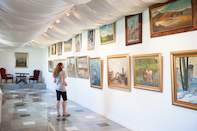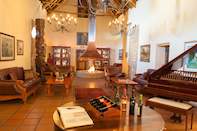A Russian émigré imbued this old family wine farm with eclectic charm, combining fine wine and food with Cape Dutch history and Russian art and culture in a thoroughly laid-back environment in the early 1990s, gradually renovating and expanding its offerings to become a modern, multi-facetted, family friendly wine tourism destination straddling different ages and cultures.
Early Impressions

Where Cape Town’s northern suburbs give way to the vineyards of Stellenbosch lies Hazendal Wine Estate. This wine farm in Stellenbosch could only have been described as eclectic in its early days of development by Ukranian-born Russian émigré Mark Voloshin.
White gateposts marked the start of a road that meandered through a reed bed of bulrushes and weeping willows and past the first hint of the farm’s varied history: a 300-year-old livestock kraal with crumbling whitewashed walls and a tilting archway.
Further on stood the 18th-century Cape Dutch manor house, with its distinctive baroque gable and solid oak door featuring an unusual filigree fanlight. The roof, originally thatched, had been tiled some decades before, an unusual feature that somehow added to the farm’s character.
Living quarters and a barn built in the early 1700s and converted into a cellar a hundred years later was converted to serve as a tasting room, where sections of exposed masonry and a collection of prints, plaques and portraits provided a window into the past.
Then and Now

The property was granted to a German settler, Christoffel Haasenwinkel in 1704 and the classic H-shaped manor house was built in 1764 by a subsequent owner, Joost van As.
His descendants finally sold to Izaak Bosman in 1831 and for the next 163 years Hazendal was home to five generations of Bosmans, whose history is depicted on a massive ‘totem pole’ topped with the bust of Oom Piet Bosman. He is credited with establishing the farm’s reputation for fine wines - originally Chenin Blanc but later reds.
Caught in Oom Piet’s stern gaze is a portrait of owner for nearly three decades, Mark Voloshin, who bought the struggling farm in 1994 and, with long-term partner Leo Schumacher, breathed new life into it. Born in Moscow where he studied dentistry, Voloshin’s links to his Russian heritage have remained strong, as shown by the Marvol Museum of Russian Arts and Culture.
It’s a nostalgic collection of porcelain, samovars, exquisite wooden religious icons and traditionally painted Easter eggs. There is also an interesting collection of Russian oils to view. Subsequent developments, encompassing farm outbuildings and taking the farm’s offerings to a new level, have continued to celebrate its Cape Dutch character, with nods to the owner’s proud Russian heritage.
There is the Babushka Deli, including delicacies such as blini and caviar, high tea fare featuring the traditional samovar tea pot, and the convivial long-table dinners in the magical glass-enclosed Glasshouse restaurant.
The original Cape Dutch manor has been re-thatched and refurbished with a mixture of old Cape and Russian artefacts (including treasures by artists Tretchikoff and Pierneef), its five bedrooms offered as a single unit, ideal for a wedding party (there are seven wedding venue options), golfing group (playing the 3-par 18-hole course) or extended family/friend group.
Children are fully catered for and kept occupied under supervision at the expansive Wonderdal indoor and outdoor interactive and educational space, including their own putting park.
What About the Wines

Hazendal’s sizable tasting area, in the farm’s original old wine cellar aptly re-imagined as the Wine Lounge, allows for both lounging and perching, featuring comfortable sofas and bistro-style seating around a large central hearth with burnished copper flue and a sophisticated, modern set-up for tutored tastings. In an adjoining ante-room, plate-glass panels overlook the stainless steel tanks and oak barrels in the compact, modern cellar.
Red wines, particularly Cabernet Sauvignon and Shiraz, are the farm’s forte, and it was a Shiraz/Cabernet blend that won for former winemaker Ronell Wiid the prestigious annual Diners Club Winemaker of the Year Award in 1999 - the first time it went to a woman. Now it’s Clarise Sciocatti-Langeveldt’s turn to nurture both vineyards and wines.
Among the standard white classics, Chenin Blanc is another specialty, with an elegant, fruity wooded version produced from decades-old bush vines that were the source of well-loved Hazendal ‘Steen’ wines during the Bosman era.
A more uncommon-to-the-Cape Roussane has been added to the mix. And there are now two methods Cap Classique bottle-fermented bubblies under the new Hazendal 23.5 label: a pure Chardonnay Blanc de Blancs and beautiful blush Blanc de Noir from pinot noir.
Despite - or perhaps because of - its charming eclecticism, Hazendal has formerly had a delightfully laid-back ambiance. A sunny summer’s day calls called for a leisurely lunch on the lawn, and there is was plenty of room from an impromptu game of cricket or soccer - and plenty of bread crusts to feed to the geese and ducks on the farm dam.
Its recent development, expansion and refurbishment of multiple foods, wine (and craft beer), conferencing, entertainment (now including a jazz dinner club) and accommodation venues, demarcated by manicured lawns, herb and flower gardens and shrubbery, low walls and meandering walkways, has retained its welcoming air, but wrapped it in sophistication and modernity.
 Stellenbosch is arguably the wine capital of South Africa. Winemaking dates back to its settlement in the 17th century and remains the lifeb...
Stellenbosch is arguably the wine capital of South Africa. Winemaking dates back to its settlement in the 17th century and remains the lifeb...